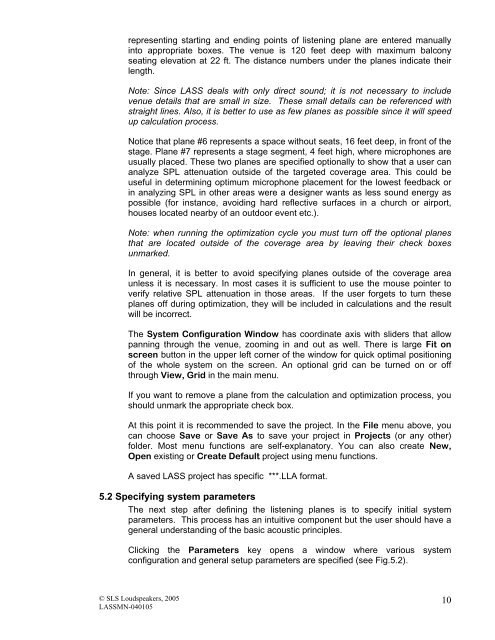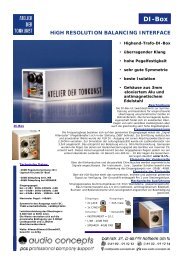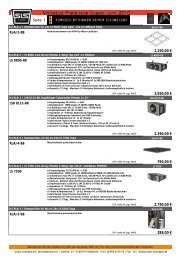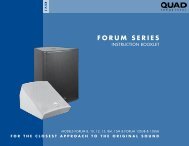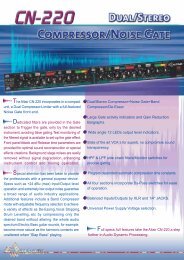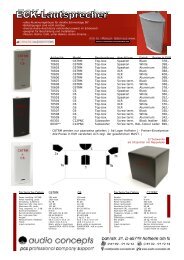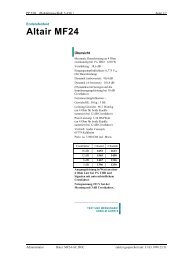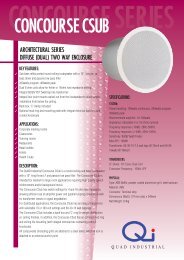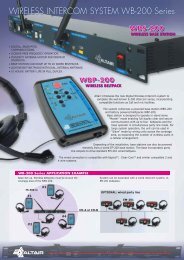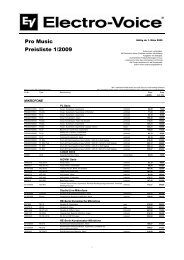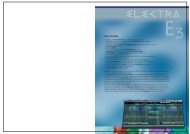LASS user manual - audio concepts
LASS user manual - audio concepts
LASS user manual - audio concepts
Create successful ePaper yourself
Turn your PDF publications into a flip-book with our unique Google optimized e-Paper software.
epresenting starting and ending points of listening plane are entered <strong>manual</strong>ly<br />
into appropriate boxes. The venue is 120 feet deep with maximum balcony<br />
seating elevation at 22 ft. The distance numbers under the planes indicate their<br />
length.<br />
Note: Since <strong>LASS</strong> deals with only direct sound; it is not necessary to include<br />
venue details that are small in size. These small details can be referenced with<br />
straight lines. Also, it is better to use as few planes as possible since it will speed<br />
up calculation process.<br />
Notice that plane #6 represents a space without seats, 16 feet deep, in front of the<br />
stage. Plane #7 represents a stage segment, 4 feet high, where microphones are<br />
usually placed. These two planes are specified optionally to show that a <strong>user</strong> can<br />
analyze SPL attenuation outside of the targeted coverage area. This could be<br />
useful in determining optimum microphone placement for the lowest feedback or<br />
in analyzing SPL in other areas were a designer wants as less sound energy as<br />
possible (for instance, avoiding hard reflective surfaces in a church or airport,<br />
houses located nearby of an outdoor event etc.).<br />
Note: when running the optimization cycle you must turn off the optional planes<br />
that are located outside of the coverage area by leaving their check boxes<br />
unmarked.<br />
In general, it is better to avoid specifying planes outside of the coverage area<br />
unless it is necessary. In most cases it is sufficient to use the mouse pointer to<br />
verify relative SPL attenuation in those areas. If the <strong>user</strong> forgets to turn these<br />
planes off during optimization, they will be included in calculations and the result<br />
will be incorrect.<br />
The System Configuration Window has coordinate axis with sliders that allow<br />
panning through the venue, zooming in and out as well. There is large Fit on<br />
screen button in the upper left corner of the window for quick optimal positioning<br />
of the whole system on the screen. An optional grid can be turned on or off<br />
through View, Grid in the main menu.<br />
If you want to remove a plane from the calculation and optimization process, you<br />
should unmark the appropriate check box.<br />
At this point it is recommended to save the project. In the File menu above, you<br />
can choose Save or Save As to save your project in Projects (or any other)<br />
folder. Most menu functions are self-explanatory. You can also create New,<br />
Open existing or Create Default project using menu functions.<br />
A saved <strong>LASS</strong> project has specific ***.LLA format.<br />
5.2 Specifying system parameters<br />
The next step after defining the listening planes is to specify initial system<br />
parameters. This process has an intuitive component but the <strong>user</strong> should have a<br />
general understanding of the basic acoustic principles.<br />
Clicking the Parameters key opens a window where various system<br />
configuration and general setup parameters are specified (see Fig.5.2).<br />
© SLS Loudspeakers, 2005<br />
<strong>LASS</strong>MN-040105<br />
10


